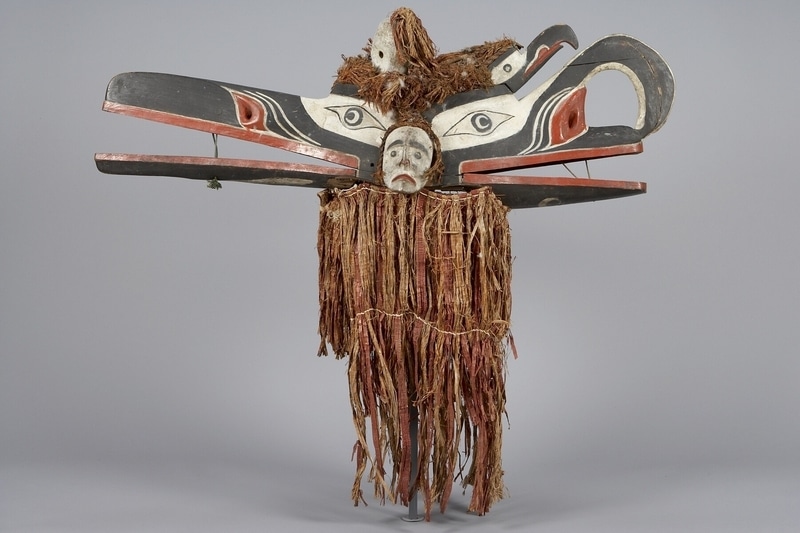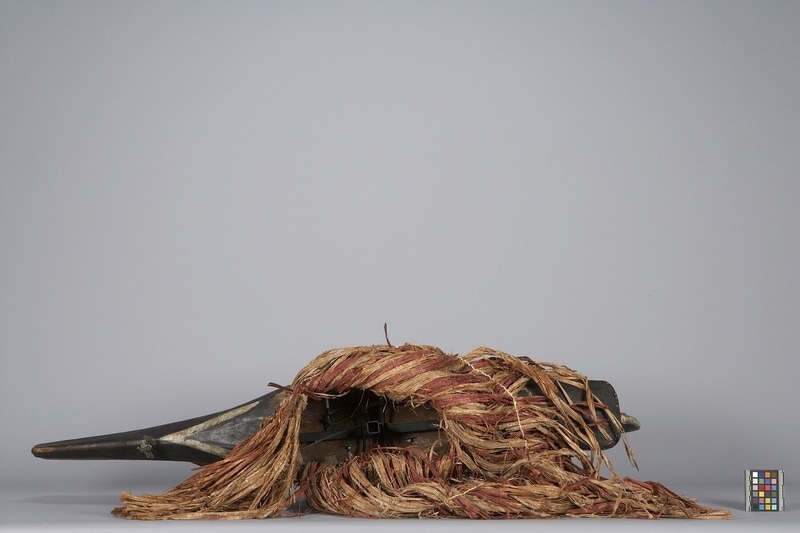Mask Item Number: A4169 from the MOA: University of British Columbia




Description
Bird mask with a crooked beak and a raven, carved back to back. Both have flared s-shaped red nostrils. The crook beak has a large central frill that protrudes outward from the brow and curves inward to the centre tip of the beak. The mouths are red and protruding, the raven’s beak is pointed while the crook beak is rectangular shaped. The bottom parts of the beaks are hinged with rectangular pieces of leather. The faces are black with white detailing. The eyes are black, outlined in white on a white ovoid shaped ground; brow is black. Above the crooked beak is a small bird's head with curved beak with a similar appears to the other birds. Skull is attached at the crown of the two birds. On each side of the mask is a carved human face painted white with black and red detailing. Attached to the top are bundles of small stripes of cedar bark that are intertwined with tufts of eagle down. Hanging from the central bottom are long strips of cedar that would cover the wearer. The mask is painted black, white and red with Northwest Coast stylized forms.
History Of Use
Worn by Hamats!a dancer.
Iconographic Meaning
Represents Crooked Beak of Heaven: Galugwadzawe', and raven, Gwaxgwaxwalanuxsiwe', servants of Baxwbakwalanuxsiwe': cannibal at the north end of the world. Skulls represent cannibalism of Hamats!a (B. Willie, 1966).
Narrative
"From Owikeno: awik!inux, as were all multiple masks," (B. Willie, 1966).
Item History
- Made in British Columbia, Canada before 1952
- Collected in Village Island, British Columbia, Canada and 'Mimkwamlis, British Columbia, Canada
- Owned by Chief Harry Mountain before November 17, 1952
- Received from H. R. MacMillan (Funding source) and Chief Harry Mountain (Seller) on November 17, 1952
What
- Name
- Mask
- Identification Number
- A4169
- Type of Item
- mask
- Material
- cedar wood, eagle down feather, fibre, cedar bark, metal, paint and leather skin
- Overall
- height 41.7 cm, width 30.5 cm, depth 128.9 cm
Who
- Culture
- Kwakwaka'wakw
- Previous Owner
- Chief Harry Mountain
- Received from
- H. R. MacMillan (Funding source) and Chief Harry Mountain (Seller)
Where
- Holding Institution
- MOA: University of British Columbia
- Made in
- British Columbia, Canada
- Collected in
- Village Island, British Columbia, Canada and 'Mimkwamlis, British Columbia, Canada
When
- Creation Date
- before 1952
- Ownership Date
- before November 17, 1952
- Acquisition Date
- on November 17, 1952
Other
- Condition
- good
- Current Location
- Case 35
- Accession Number
- 2006/0016